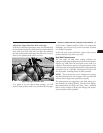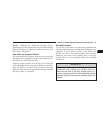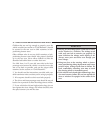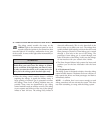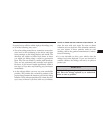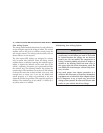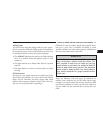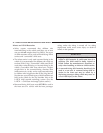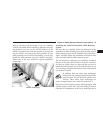
The airbag control module also turns on the
AIRBAG light in the instrument panel for 6 to 8
seconds when the ignition is first turned on, then
turns the light off. If it detects a malfunction in any part
of the system, it turns on the light either momentarily or
continuously.
WARNING!
Ignoring the AIRBAG light in your instrument panel
could mean you won’t have the airbags to protect
you in a collision. If the light does not come on, stays
on after you start the vehicle, or if it comes on as you
drive, have the airbag system checked right away.
•
When the airbag control module detects a collision
requiring the airbags, it signals the inflator units. A
large quantity of nontoxic gas is generated to inflate
the airbags. Three levels of airbag inflation rates are
possible. These rates are determined by the airbag
control module based on collision severity. The airbag
covers separate and fold out of the way as the airbags
inflate to their full size. The airbags fully inflate in
about 60 milliseconds. This is only about half of the
time it takes you to blink your eyes. The airbags then
quickly deflate while helping to restrain the driver and
front passenger. The driver’s front airbag gas is vented
through a vent hole in the rear of the airbag. The
passenger’s front airbag gas is vented through vent
holes in the sides of the airbag. In this way the airbags
do not interfere with your control of the vehicle.
•
The Knee Impact Bolsters help protect the knees and
position you for the best interaction with the front
airbag.
If A Deployment Occurs
The airbag system is designed to deploy when the airbag
control module detects a moderate-to-severe collision, to
help restrain the driver and front passenger, and then to
immediately deflate.
NOTE:
A collision that is not severe enough to need
airbag protection will not activate the system. This does
not mean something is wrong with the airbag system.
38 THINGS TO KNOW BEFORE STARTING YOUR VEHICLE




